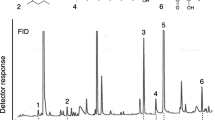Abstract
Behavioral evidence indicates that (Z)-9-hexadecenal (Z9-16∶ALD) is a trail pheromone component ofIridomyrmex humilis, and that the true trail pheromone may be multicomponent. Trail-following responses ofI. humilis workers to several concentrations of syntheticZ9-16∶ALD, a constituent of the Pavan's gland, were found to be comparable to responses to gaster extract trails containing ca. 100 times lessZ9-16∶ALD. Of the five aldehyde analogs tested, only (Z)-7-hexadecenal (Z7-16∶ALD) elicited significant trail-following. However, following responses to severalZ9-16∶ALD-Z7-16∶ALD combinations were lower than responses toZ9-16∶ALD alone. Trails on filter paper of biologically relevant concentrations ofZ9-16∶ALD lose activity within 2 hr in the laboratory. The release rate ofZ9-16∶ALD measured from filter paper trails was 0.25 ± 0.10 pg/cm-sec. This was used to estimate the trail-following threshold for this compound of Argentine ant workers.
Similar content being viewed by others
References
Baker, T.C., Gaston, L.K., Pope, M.M., Kuenen, L.P.S., andVetter, R.S. 1981. A high efficiency collection device for quantifying pheromone volatilized from female glands and synthetic sources.J. Chem. Ecol. 7:961–968.
Barlin, M.R., Blum, M.S., andBrand, J.M. 1976. Fire ant trail pheromones: Analysis of species specificity after gas chromatographie fractionation.J. Insect Physiol. 22:839–844.
Benthuysen, J.L., andBlum, M.S. 1974. Quantitative sensitivity of the antPogonomyrmex barbatus to the enantiomers of its alarm pheromone.J. Ga. Entomol. Soc. 9(4):235–238.
Blum, M.S., Doolittle, R.E., andBeroza, M. 1971. Alarm pheromones: Utilization in evaluation of olfactory theories.J. Insect Physiol. 17:2351–2361.
Caputo, J.F., Caputo, R.E., andBrand, J.M. 1979. Significance of the pyrrolic nitrogen atom in receptor recognition ofAtta texana (Buckley) (Hymenoptera: Formicidae) trail pheromone and parapheromones.J. Chem. Ecol. 5(2):273–278.
Cavill, G.W.K., Robertson, P.L., andDavies, N.W. 1979. An Argentine ant aggregation factor.Experientia 35:989–990.
Cavill, G.W.K., Davies, N.W., andMcdonald, F.J. 1980. Characterization of aggregation factors and associated compounds from the Argentine ant,Iridomyrmex humilis.J. Chem. Ecol. 6(2):371–384.
Cross, J.H., Bvler, R.C., Ravid, U., Silverstein, R.M., Robinson, S.W., Baker, P.M., Sabino de Oliveira, J., Jutsom, A.R., andCherrett, J.M. 1979. The major component of the trail pheromone of the lear-cutting ant,Atta sexdens rubropilosa Forel.J. Chem. Ecol. 5(2):187–203.
DeBach, P.,Dietrick, E.J., andFleschner, C.A. 1951a. Ants vs. biological control.Citrus Leaves (May, 1951), 8–9, 17–18, 42.
DeBach, P., Fleschner, C.A., andDietrick, E.J. 1951b. A biological check method for evaluating the effectiveness of entomophagous insects.J. Econ. Entomol. 44:763–766.
Gaston, L.K., Payne, T.L., Takahashi, S., andShorey, H.H. 1972. Correlation of chemical structure and sex pheromone activity inTrichoplusia ni (Noctuidae), pp. 167–273,in D. Schneider (ed.). Olfaction and Taste IV. Wissenschaftliche Verlagsgesellschaft MBH, Stuttgart.
Howard, R., Matsumura, F., andCoppel, H.C. 1976. Trail-following pheromones of the Rhinotermitidae: Approaches to their authenticity and specificity.J. Chem. Ecol. 2(2):147–166.
Parry, K. andMorgan, E.D. 1979. Pheromones of ants: A review.Physiol. Entomol. 4:161–189.
Priesner, E., Jacobson, M., andBestmann, H.J. 1975. Structure-response relationships in noctuid sex pheromone reception.Z. Naturforsch. 30:282–293.
Riley, R.G., Silverstein, R.M., andMoser, J.C. 1974. Isolation, identification, synthesis and biological activity of volatile compounds from the heads ofAtta ants.J. Insect Physiol. 20:1629–1637.
Ritter, F.J., Bruggemann-Rotgans, I.E.M., Verwiel, P.E.J., Talman, E., Stein, F., La Brijn, C., andPersoons, C.J. 1977. Faranal, a trail pheromone from the Dufour's gland of the Pharaoh's ant, structurally related to juvenile hormone.Proc. 8th Int. Congr. IUSSI, Wagenigen, Netherlands, pp. 41–43.
Robinson, S.W., andCherrett, J.M. 1973. Studies of the use of leaf-cutting and scent trail pheromones as attractants in baits. 1973.Proc. VII. Congr. IUSSI, London, pp. 332–338.
Robinson, S.W., andCherrett, J.M. 1975. Some reactions of leaf-cutting ants (Attini: Formicidae) to a synthetic scent-trail pheromone, pp. 91–97,in Ch Noirot, P.F. Howse, andG. LeMasne, (eds.). Pheromones and Defensive Secretions in Social Insects. Proc. Symp. IUSSI, Dijon.
Roelofs, W.L., andComeau, A. 1971. Sex pheromone perception: Synergists and inhibitors for the redbanded leafroller attractant.J. Insect Physiol. 17:435–448.
Sonnet, P.E., andMoser, J.C. 1972. Synthetic analogues of the trail pheromone of the leaf-cutting ant,Atta texana (Buckley).J. Agric. Food Chem. 20(6):1191–1194.
Sonnet, P.E., andMoser, J.C. 1973. Trail pheromones: Responses of the Texas leafcutting ant,Atta texana to selected halo- and cyanopyrrole-2-aldehydes, ketones, and esters.Environ. Entomol. 2(5):851–854.
Tumlinson, J.H., Moser, J.C., Silverstein, R.M., Brownlee, R.G., andRuth, J.M. 1972. A volatile trail pheromone of the leaf-cutting ant,Atta texana.J. Insect Physiol. 18:809–814.
Van Vorhis Key, S.E., Gaston, L.K., andBaker, T.C. 1982. Effects of trail concentration on the trail following behavior of the Argentine ant,Iridomyrmex humilis.J. Insect Physiol. 27(6): 363–370.
Author information
Authors and Affiliations
Rights and permissions
About this article
Cite this article
Van Vorhis Key, S.E., Baker, T.C. Trail-following responses of the Argentine ant,Iridomyrmex humilis (Mayr), to a synthetic trail pheromone component and analogs. J Chem Ecol 8, 3–14 (1982). https://doi.org/10.1007/BF00984000
Received:
Revised:
Issue Date:
DOI: https://doi.org/10.1007/BF00984000




